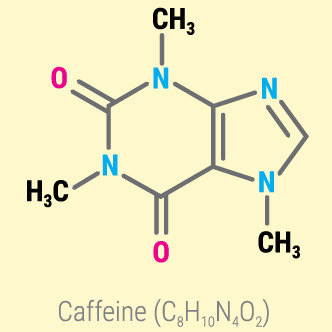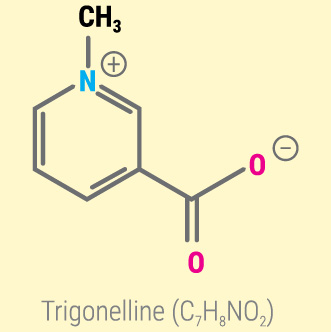Components of coffee1:
- 0,1 % Volatile aromatic substances
- 0,8 – 2,5 % Alkalines
- 4 % Minerals
- 4 – 5 % Acids
- 11 % Proteins
- 10 – 13 % Water
- 10 – 13 % Lipids
- 30 – 40 % Carbohydrate
A coffee bean has more than a million cells. During roasting, more than a thousand different variable compounds, of whose 850 are known, appear, as if they hide in a safe place and come out by roasting. 2
The following sample gives us the considerable effect of each cell making coffee so characteristic.
1.000.000 cells (per bean)
(1.000 aromatic compounds) x (50 beans per cup) = 50.000.000 aromatic compounds
Raw coffee beans are dense, green seeds consisted of about one-half carbohydrate in various forms and one-half a mixture of water, proteins, lipids, acids, and alkaloids by volume.
Roasters do not need to know much about green coffee’s chemistry to roast delicious coffee, but we offer the following summary to familiarize readers with the primary components of green coffee. 3
A raw coffee bean’s structure is a three dimensional cellulose or polysaccharide matrix containing approximately a million cells.
Coating the cellulose strands within that matrix are hundreds of chemicals that the roasting process will transform into the oils and soluble materials which determine brewed coffee’s flavor. Green coffee’s cellulose structure provides half of its dry weight. The cellulose helps little to coffee flavor but does trap some volatile compounds. These compounds are responsible for the aroma and increase brewed coffee’s viscosity together with its perceived body.
Moisture content
Ideally, water should account for 10.5% to 11.5% of green coffee weight. 4
If moisture content is too low, bean color is typically faded and the cup has notes of hay and straw. A roaster must apply heat cautiously to low-moisture beans, as they are likely to roast too fast.
If moisture content is much higher than 12%, green coffee is prone to developing mold, and may taste grassy in the cup. Water slows heat transfer within beans, and it requires extra heat input to evaporate. Therefore, roasting the very moist beans requires extra energy, added time and roasting power.
Sugars
Sugars, dominated by sucrose, make up 6% to 9% of a green bean’s dry weight and provide sweetness in the cup. 5
Sucrose also contributes to development of acidity, as the caramelization of sucrose during roasting yields acetic acid.
Lipids
Lipids, primarily triglycerides, make up approximately 16% of green coffee’s dry weight. 6 Although lipids are not water soluble, brewed coffee contains some, especially when the brewing method uses either no filtration or a very porous filter.
Lipids in brewed coffee help retain aroma and contribute to coffee’s mouthfeel.
Unfortunately, lipids also present challenges to quality, as they are vulnerable to oxidation and rancidity during storage of roasted beans.
Proteins
Proteins and free amino acids make up 10% to 13% of green coffee by dry weight. 7
Amino acids and reducing sugars in coffee beans interact during roasting in nonenzymatic browning reactions known as Maillard reactions. These reactions produce glycosylamines and melanoidins that contribute to coffee’s bittersweet flavor, brown color, and roasted, meaty, and baked aromas.
Alkaloids; Caffeine and Trigonelline
Two alkaloids, caffeine and trigonelline, each account for approximately 1% of green coffee’s dry weight. 2 They are responsible for much of coffee’s bitterness and stimulating properties.
Caffeine contributes approximately 10% of coffee’s bitterness and the majority of its stimulant effect. Coffee plant produces caffe- ine as a defense against insects. A coffee tree grown at high altitudes would probably produce beans with less caffeine because of the lower risk of insect attacks.
Trigonelline, the greatest contributor to coffee’s bitterness, yields many aromatic compounds, and degrades to pyridines and nicotinic acid during roasting. 8
Nicotinic acid, also known as niacin or vitamin B, is present about 40 mg in 100 g of dark roasted coffee extract.
Coffee contains 20 to 80 ml of niacin, responsible for coffee’s anti-cavity effect, depending on the degree of brewing. 9
Organic acids
Organic acids, primarily chlorogenic acids (CGAs), constitute approximately 7% to 10% of green coffee’s dry mass. 10
CGAs contribute to coffee’s acidity, sourness, astringency, and bitterness. Robusta coffee’s higher CGA content is likely responsible for its significantly greater bitterness. 11
CGAs offer antioxidant benefits for both the coffee bean and the coffee drinker. Other organic acids in coffee include citric, quinic, caffeic, malic, acetic, and formic acids.
Gases and aromatic compounds
Volatile aromatic compounds produce the coffee aroma. Although there are more than 200 volatiles in green coffee, their contribution to the aroma is negligible.
Roasting causes most of the coffee’s aromatic compounds. The reseachers explored more than 800 aromatic compounds in roasted coffee so far. 12
1-Roast Magazine
2-Tea & Coffee Magazine
3-Ian Bersten, B. Com (ECS).Coffee Floats Tea Sinks
4. C&Ci Magazine
5. Hierl, Tobias – Wechselberger, Johanna – Kreuer, Jill. The Ultimate Coffee Book for Beginners and Professionals. 2011
6. BSCA Magazine
7. Coffee Magazine
8.Roast Magazine
9.Eccardi, Fulvio – Sandalj, Vincenzo. Coffee; A Celebration of Diversity
10.Coffee Europa Magazine
11.Zimmer, Susan. I Love Coffee
12.Coffee Fest Magazine


















